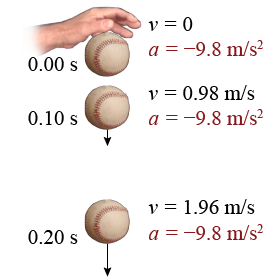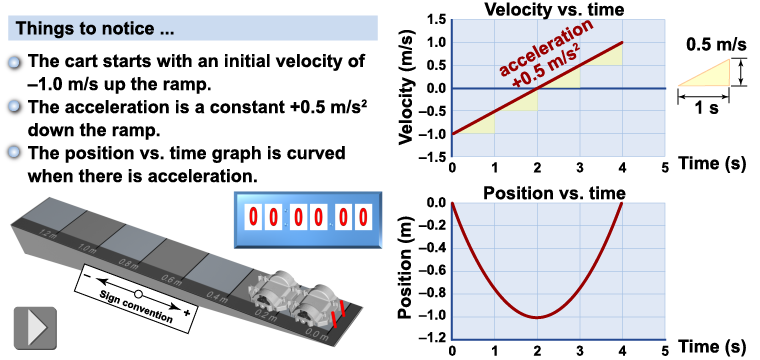|
 Acceleration is the rate at which velocity changes. Even when an object has zero velocity, it can still have a nonzero acceleration. Consider dropping a ball from your hand. The ball is not moving initially, and the instant your fingers release the ball it still has zero velocity. One tenth of a second later the ball is moving downward at −0.98 m/s. That means that the ball was accelerating from the moment it was released, even though its velocity was zero at that instant.
Acceleration is the rate at which velocity changes. Even when an object has zero velocity, it can still have a nonzero acceleration. Consider dropping a ball from your hand. The ball is not moving initially, and the instant your fingers release the ball it still has zero velocity. One tenth of a second later the ball is moving downward at −0.98 m/s. That means that the ball was accelerating from the moment it was released, even though its velocity was zero at that instant. 
|
Be very careful interpreting the signs of velocity and acceleration. Many problems define positive as the expected direction of motion, such as down a ramp. In this case the acceleration of a car released from rest is also positive. Now think about what happens if the car is initially moving up the ramp. Is the acceleration still positive? How do we explain that the car moves upward, turns around, and rolls back down again? 
|
The car in the diagram below has an initial upward velocity of −1 m/s. The constant downward acceleration adds +0.5 m/s to the velocity every second. The car’s velocity starts negative then becomes 0.5 m/s more positive each second until v = 0. At the car’s highest point its velocity is zero. After the turn-around, acceleration and velocity point in the same direction. Acceleration remains a constant +0.5 m/s2 even though the sign of the velocity changes! 
 |
The term deceleration is used to describe situations where speed decreases. Deceleration does not mean the same thing as negative acceleration! Negative accelerations can cause an object to speed up or slow down, depending on the sign of its velocity. If an object has a positive velocity and a negative acceleration, then it will slow down, or decelerate. But if an object has a negative velocity and a negative acceleration, then it will actually speed up as its velocity becomes more negative every second. The term acceleration can be used for all changes in velocity, including speeding up or slowing down in any direction. 
|

|
Situations in which an object reverses direction always involve an acceleration that has the opposite sign from that of the velocity. For example, an acceleration of −1 m/s2 adds −1 m/s to the velocity every second, so an initial positive velocity of +3 m/s becomes +2 m/s after one second, and then +1 m/s, 0 m/s, −1 m/s, etc. Objects reverse direction when their velocity becomes zero and then change sign. This fact is useful in solving many physics problems and in interpreting graphs. 
|
| |
|

